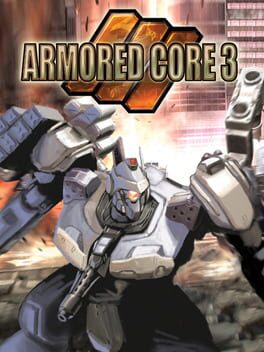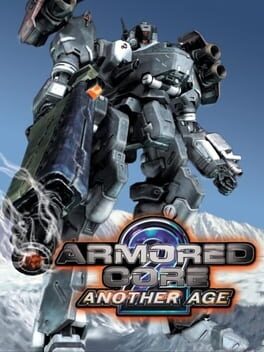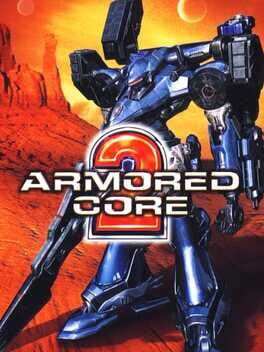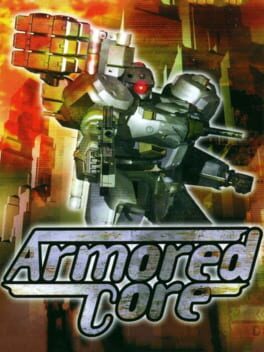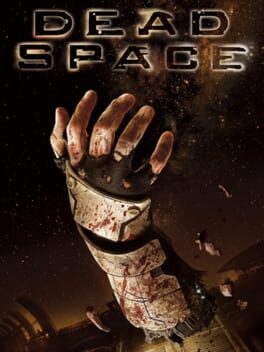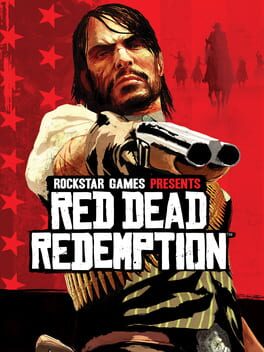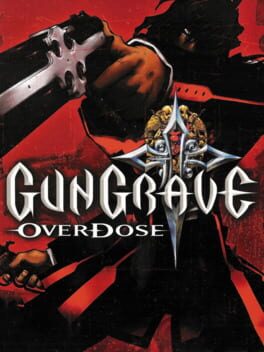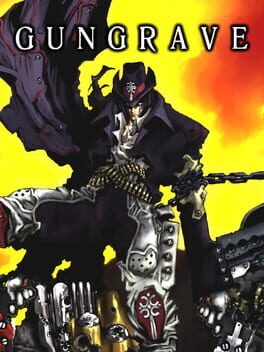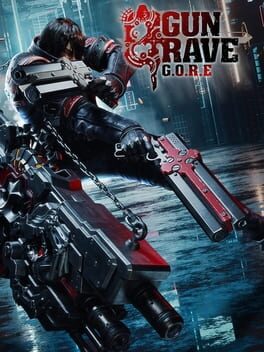vaugna16
2002
it is JUST missions, one after the other with very little in the way of story or any other bs. Armored Core in its purest form perhaps. 100 missions is a LOT though, and quality can vary drastically and it can be very tiring if you're trying to do it all in one go - pace yourself on this one. Got pretty burnt out about 2/3 of the way through, but I do want to go back and wrap it up
2000
1997
2022
2023
2008
2010
2004
2002
2022
Critical Review From a Fan of the Original Gungrave
In the lead up to Gungrave G.O.R.E I decided to go through the entire Gungrave media catalog and made a shocking discovery – the original Gungrave is genuinely fantastic. It’s an excellently designed arcade shooter with loads of early 2000s anime style to back it up. The extremely loose anime adaptation is just as fantastic, expanding greatly on the characters and turning them from cool but one note artbook designs to fleshed out, larger than life figures. The game sequel Overdose however fell pretty flat for me, with a significantly weaker presentation and much sloppier game design (it does have a character named Rocketbilly Redcadillac tho, so that’s a few points in its favor). I attempted to play the VR game but it was so utterly forgettable and clearly a tech demo for an early version of GORE that barely resembles the final game that it’s barely worth bothering with.
With all that preamble I had my expectations pretty much set for G.O.R.E – I expected it to be decently fun, but not as good as the original game. For the most part my expectations were met, but there's a lot that as a big fan of the original game just doesn't hold up. I have no doubt G.O.R.E will reach some new fans and will probably become a cult classic in a decade, and if you have Game Pass it's worth trying out. But for now I want to go over why it just didn't really work for me.
The biggest change out of the gate in G.O.R.E are the controls. Gone are the semi-tank controls, replaced with a more “modern” dual stick set up with a very generous auto aim reticle. I’m generally of the mindset that unconventional control schemes should be embraced in the face of an ever-homogenized gaming landscape, but this change is ultimately pretty harmless. Not without drawbacks though – moving from the right thumbstick to the face buttons can feel cumbersome sometimes. The dodge maneuver gets the worst of it, it no longer feels silky smooth to pull off dodge shots when instead of simply bringing your thumb down without stopping shooting you have to move it across the controller and stop aiming for a second. Dodging can also feel pretty unresponsive at times, sometimes not coming out despite feeling like it should have or getting scraped by an attack while dodging that it really feels like you should have avoided.
Melee combat in the original game consisted of one attack, basically a get-off-me move you could also use to be hot shit and get style points. It fit with the game’s design but was pretty limited. This was expanded somewhat in Overdose to add a three hit combo, but this was generally unresponsive and not very good. This is one area where G.O.R.E greatly improves on the previous games. There are unlockable combos that serve different purposes like crowd control, pushing through enemies, or laying on thick damage to single targets and they all feel great. It definitely isn’t Devil May Cry and shooting should still remain your main choice of attack but melee combat as a whole is much more useful. There is one downgrade to melee however – in Overdose, the three hit combo could deflect rockets as well as the standing still “Death Tornado” move but in G.O.R.E only Death Tornado has any effect on them, with rockets phasing right through combo moves.
There are some upsides to how demolition shots work now but some odd decisions as well. In the original and Overdose you gained demolition shots by your performance at the end of stages, graded via skull points. The amount of demolition shots you could hold was also consistent across the whole game. In G.O.R.E, you start off with only one demolition shot gauge slot and have to purchase more and new demolition shot types in the new upgrade menu. I’m mixed on the addition of the upgrade menu – it definitely feels like a concession made to G.O.R.E being a modern game and some upgrades just feel like point dumps, i.e. your base shot power is absolutely pitiful and should be upgraded a few times right away. Upgrades like “10% more of X stat” feel a bit antithetical to Gungrave’s mission statement as a whole. On the flip side, I don’t mind buying the demolition shots and gauge slots. It’s a take on the previous system of gaining them based on your performance while offering additional freedom to tailor your demolition shot loadout to your liking. Being able to reset your upgrades at no penalty is also very welcome to experimentation and finding what works best for you. Actually firing demolition shots feels like an improvement too, with them being selected from a face button shortcut while holding the left trigger as opposed to having to navigate through a menu to select one.
Stage and enemy design is one of the things that makes the original Gungrave such an infinitely replayable game in my opinion – it’s an all killer no filler approach, impeccably designed with the player’s abilities in mind and kept short enough you can reasonably memorize layouts and patterns for repeat playthroughs. G.O.R.E takes a quantity over quality approach, being by far the longest game in the series with the longest stages but as a result the individual stage design suffers a fair bit. Each of the areas is fairly memorable but with rare exceptions the 4-6 individual stages contained within each tend to blur together and the game ends up feeling padded out as a result. It’s not helped that instead of the short and sweet ten minute stages of the original, G.O.R.E’s can go on for fifteen, even upwards of twenty minutes with most stages well wearing out their welcome by the time they’re over. The design within also feels very inconsistent. Which props can be destroyed to keep up a beat count seems to vary from each individual prop – sometimes you can blow up barrels and cars, sometimes you can’t. This inconsistency compared to the original game’s ability to blow up virtually everything to keep a beat count going makes going for long beat counts discouraging in G.O.R.E. Another big knock on G.O.R.E’s stage design and replayability is the large amount of instant deaths in some stages. In the original game there were no instant deaths pits, you would just have to climb your way back up. One early stage in G.O.R.E however is memorable for the wrong reasons, where you are stuck on a train with shotgun enemies that can easily knock you off and barely any time to make it to the end before being cut off by a tunnel. The last area’s levels are particularly poor, featuring long corridors filled with dozens of the tankiest enemies in the game.
Enemy design is a mixed bag overall. Enemy AI is very dumb and very aggressive, tending to make a beeline straight for you. While diving out of harm’s way and pushing forward was the name of the game in the original in G.O.R.E it’s all about circle strafing around groups chasing you and moving backwards. The new controls at least facilitate this reasonably well, though there are many instances where enemies can lock you into a corner and cook you. The already kind of iffy burst mode maneuver – where you stay still while shooting to start stylishly firing while being able to rotate – is particularly useless in G.O.R.E since enemies will just run up to sucker punch you, though there is a new take on it where at 50 beats you can tap Y/triangle to do a particularly fast version that still leaves you vulnerable but can rack up huge beat counts and demolition gauge gains on close groups of enemies.
There are a handful of particularly annoying enemy types – the laser soldiers are the worst, with the timing on dodging their lasers never feeling consistent leading to either popping a demolition shot to get rid of them asap or resorting to some very un-Gungrave-like bitch strats of moving in and out of cover. The homing rocket soldiers are also very annoying as they’re relentless in their attacks and can’t be as easily dodged as normal rockets. The shotgunners aren’t too bad in most stages, but levels with pits turn them into a nightmare. Some enemies also toss gas that disables the auto aim reticlewhich isn’t particularly hard to work around but can still be quite an annoyance. Boss design ranges from kind of bad to pretty decent – the big end bosses of each area can be pretty tough, but are satisfying to learn and eventually overcome. The midbosses on the other hand tend to just be annoying exercises in circle strafing and questionable hitboxes.
Your shield, which protects your health bar from attacks and can regenerate after not getting hit for a bit Halo-style, seems particularly low in G.O.R.E. In the original game you ideally would never run out of your shield to get a max HP score at the end of the stage but this seems like it would be impossible with how stronger enemies in G.O.R.E can wipe your shield out in one or two hits. In theory this should be counteracted with the new glory kill-esque “R.I.P” attack that regains shield but enemies don’t consistently go into a staggered state near low health, often just dying before staggering so you can’t really count on R.I.P to save your hide. You can R.I.P from a distance with a hookshot/devil grab-esque move that I’m only mentioning now because it’s pretty useless. You can grab an enemy from afar to use as a shield but while it helps in a pinch this doesn’t get much use since it only works on the weakest tier of enemies and most later game encounters involve huge waves of stronger types.
That pretty much wraps up my criticisms on the gameplay, so let’s talk about the presentation. The original Gungrave is easily the coolest game you could make in 2002 - original concept and character designs by Yasuhiro Nightow (mangaka of Trigun), mechanical designs by Kosuke Fujishima (mangaka of Ah! My Goddess and character designer for Sakura Wars), prerendered cinematics by Romanov Higa (creator of Urda: The Third Reich), and music by Tsuneo Imahori (composer for the Trigun TV anime and guitarist for The Seatbelts). This pool of talent culminated in an incredibly stylish and memorable presentation that, combined with Sega's decision in localization to keep the stacked Japanese voice cast, nailed the feeling of being a playable piece of cutting edge turn of the millennium Japanese art. The sequel Overdose, while keeping much of the same creative staff, felt a bit more stretched out in its budget and didn't quite keep up the same energy despite some great new character designs like Rocketbilly Redcadillac. The original's simple but effective story also gave way to a confusing mess of a plot in Overdose, now told mostly through static dialogue scenes. The extremely loose anime adaptation of the first game fared much better, nailing a more grounded tone thanks to Madhouse's direction and an excellent English dub with Tsuneo Imahori returning to do the soundtrack.
So with that in mind, how does G.O.R.E's presentation fare? If I had to describe G.O.R.E's presentation in one word it would be "rough". There's some good here - Yasuhiro Nightow worked more broadly as the "image director", overseeing the designs and naming some of the new elements. Ikumi Nakamura, known for The Evil Within and Ghostwire Tokyo, joined developer IGGYMOB during development and contributed character designs. So generally speaking, the new character designs are pleasant. They do have a bit of genericness to them - Quartz and the Raven Clan bosses in particular - but aren't bad. The updated older designs are good if slightly let down by the more realistic direction - Grave and Bunji look fantastic, but Mika looks pretty off. Tsuneo Imahori sadly didn't return to do the music but the new soundtrack from Tetsuya Shibata and Yoshino Aoki, former Capcom composers who also worked on FFXV, does keep up the energy with a more buttrock-y vibe that fits the style of the game.
The game's artistic direction as a whole unfortunately feels kind of generic, looking very much like a low budget Unreal Engine 4 game. While the small handful of prerendered cinematics from Digic Pictures look great, the in-engine cutscenes are extremely rough with stilted animation and a heavy overuse of depth of field. Enemy designs are nothing to write home about, being an assortment of generic thugs and soldiers that don't have the same pizzazz the designs in the original game had. The redesigned Orgmen look particularly bad, being very top-heavy and much goofier looking.
While the Japanese cast returned along with a new Korean cast, the English dub is unfortunately pretty bad. Only Quartz's VA is a regular professional voice actor with the rest of the cast seeming to be an assortment of English-speaking actors who live in South Korea with the result being a very unprofessional sounding and miscast English voice track. Special note to Zell, played by Akio Otsuka in Japanese and Steve Blum in the dub for Overdose, who in G.O.R.E sounds very much not like a hardened military commander. When XSeed localized the VR game they brought back the voice actors from the excellent English dub of the anime for the few bits of dialogue that game had and it's unfortunate the localization of the bigger game could not do the same. The English localization as a whole is very amateurish, with loads of grammar mistakes and typos. It's especially poor in the story recap which does an overall very poor job explaining the plots of the previous games.
The story in G.O.R.E is unfortunately a nonsensical mess, feeling pretty detached from the events of previous games. There are a few attempts at fanservice in bringing some characters back but they fall pretty flat. Grave and Mika in particular feel like they have no real characterization in G.O.R.E with Grave basically just being dropped into areas to shoot stuff and Mika spending most of the game in a plot coma. My problem with the storytelling in G.O.R.E is similar to my problem with Overdose's, where they wanted to have more story than the simple but effective first game but didn't expand the depth of the story like the anime did so you end up with a lot of Proper Nouns said over and over and a plot that spins its wheels. It doesn't even really move the story of the franchise forward, with Mika being infected with SEED like in Overdose again and having to be saved again. The game tries to drop a moment at the end with Grave saying "My name is Brandon Heat." that feels wholly unearned and not set up at all by the story. The Raven Clan bosses feel like a poor attempt at recapturing what made the Millennion gang work and the main villain of the game feels like it comes out of nowhere. When it comes to story with Gungrave the best approaches are to either embrace a less is more mentality like the original game or really dig into Grave's character like the anime. With G.O.R.E it just ends up feeling bloated.
And that's pretty much my tl;dr review of Gungrave G.O.R.E - it's overbloated and bit off more than it could chew for what it's trying to do, with the occasional good qualities being overshadowed by how rough so much of it from being stretched so thin. IGGYMOB has announced a patch to retool the difficulty spikes and add a full auto option, and I hope they continue to support the game post-launch. There's almost a good game here and with some tweaking maybe one day it could reach it.
In the lead up to Gungrave G.O.R.E I decided to go through the entire Gungrave media catalog and made a shocking discovery – the original Gungrave is genuinely fantastic. It’s an excellently designed arcade shooter with loads of early 2000s anime style to back it up. The extremely loose anime adaptation is just as fantastic, expanding greatly on the characters and turning them from cool but one note artbook designs to fleshed out, larger than life figures. The game sequel Overdose however fell pretty flat for me, with a significantly weaker presentation and much sloppier game design (it does have a character named Rocketbilly Redcadillac tho, so that’s a few points in its favor). I attempted to play the VR game but it was so utterly forgettable and clearly a tech demo for an early version of GORE that barely resembles the final game that it’s barely worth bothering with.
With all that preamble I had my expectations pretty much set for G.O.R.E – I expected it to be decently fun, but not as good as the original game. For the most part my expectations were met, but there's a lot that as a big fan of the original game just doesn't hold up. I have no doubt G.O.R.E will reach some new fans and will probably become a cult classic in a decade, and if you have Game Pass it's worth trying out. But for now I want to go over why it just didn't really work for me.
The biggest change out of the gate in G.O.R.E are the controls. Gone are the semi-tank controls, replaced with a more “modern” dual stick set up with a very generous auto aim reticle. I’m generally of the mindset that unconventional control schemes should be embraced in the face of an ever-homogenized gaming landscape, but this change is ultimately pretty harmless. Not without drawbacks though – moving from the right thumbstick to the face buttons can feel cumbersome sometimes. The dodge maneuver gets the worst of it, it no longer feels silky smooth to pull off dodge shots when instead of simply bringing your thumb down without stopping shooting you have to move it across the controller and stop aiming for a second. Dodging can also feel pretty unresponsive at times, sometimes not coming out despite feeling like it should have or getting scraped by an attack while dodging that it really feels like you should have avoided.
Melee combat in the original game consisted of one attack, basically a get-off-me move you could also use to be hot shit and get style points. It fit with the game’s design but was pretty limited. This was expanded somewhat in Overdose to add a three hit combo, but this was generally unresponsive and not very good. This is one area where G.O.R.E greatly improves on the previous games. There are unlockable combos that serve different purposes like crowd control, pushing through enemies, or laying on thick damage to single targets and they all feel great. It definitely isn’t Devil May Cry and shooting should still remain your main choice of attack but melee combat as a whole is much more useful. There is one downgrade to melee however – in Overdose, the three hit combo could deflect rockets as well as the standing still “Death Tornado” move but in G.O.R.E only Death Tornado has any effect on them, with rockets phasing right through combo moves.
There are some upsides to how demolition shots work now but some odd decisions as well. In the original and Overdose you gained demolition shots by your performance at the end of stages, graded via skull points. The amount of demolition shots you could hold was also consistent across the whole game. In G.O.R.E, you start off with only one demolition shot gauge slot and have to purchase more and new demolition shot types in the new upgrade menu. I’m mixed on the addition of the upgrade menu – it definitely feels like a concession made to G.O.R.E being a modern game and some upgrades just feel like point dumps, i.e. your base shot power is absolutely pitiful and should be upgraded a few times right away. Upgrades like “10% more of X stat” feel a bit antithetical to Gungrave’s mission statement as a whole. On the flip side, I don’t mind buying the demolition shots and gauge slots. It’s a take on the previous system of gaining them based on your performance while offering additional freedom to tailor your demolition shot loadout to your liking. Being able to reset your upgrades at no penalty is also very welcome to experimentation and finding what works best for you. Actually firing demolition shots feels like an improvement too, with them being selected from a face button shortcut while holding the left trigger as opposed to having to navigate through a menu to select one.
Stage and enemy design is one of the things that makes the original Gungrave such an infinitely replayable game in my opinion – it’s an all killer no filler approach, impeccably designed with the player’s abilities in mind and kept short enough you can reasonably memorize layouts and patterns for repeat playthroughs. G.O.R.E takes a quantity over quality approach, being by far the longest game in the series with the longest stages but as a result the individual stage design suffers a fair bit. Each of the areas is fairly memorable but with rare exceptions the 4-6 individual stages contained within each tend to blur together and the game ends up feeling padded out as a result. It’s not helped that instead of the short and sweet ten minute stages of the original, G.O.R.E’s can go on for fifteen, even upwards of twenty minutes with most stages well wearing out their welcome by the time they’re over. The design within also feels very inconsistent. Which props can be destroyed to keep up a beat count seems to vary from each individual prop – sometimes you can blow up barrels and cars, sometimes you can’t. This inconsistency compared to the original game’s ability to blow up virtually everything to keep a beat count going makes going for long beat counts discouraging in G.O.R.E. Another big knock on G.O.R.E’s stage design and replayability is the large amount of instant deaths in some stages. In the original game there were no instant deaths pits, you would just have to climb your way back up. One early stage in G.O.R.E however is memorable for the wrong reasons, where you are stuck on a train with shotgun enemies that can easily knock you off and barely any time to make it to the end before being cut off by a tunnel. The last area’s levels are particularly poor, featuring long corridors filled with dozens of the tankiest enemies in the game.
Enemy design is a mixed bag overall. Enemy AI is very dumb and very aggressive, tending to make a beeline straight for you. While diving out of harm’s way and pushing forward was the name of the game in the original in G.O.R.E it’s all about circle strafing around groups chasing you and moving backwards. The new controls at least facilitate this reasonably well, though there are many instances where enemies can lock you into a corner and cook you. The already kind of iffy burst mode maneuver – where you stay still while shooting to start stylishly firing while being able to rotate – is particularly useless in G.O.R.E since enemies will just run up to sucker punch you, though there is a new take on it where at 50 beats you can tap Y/triangle to do a particularly fast version that still leaves you vulnerable but can rack up huge beat counts and demolition gauge gains on close groups of enemies.
There are a handful of particularly annoying enemy types – the laser soldiers are the worst, with the timing on dodging their lasers never feeling consistent leading to either popping a demolition shot to get rid of them asap or resorting to some very un-Gungrave-like bitch strats of moving in and out of cover. The homing rocket soldiers are also very annoying as they’re relentless in their attacks and can’t be as easily dodged as normal rockets. The shotgunners aren’t too bad in most stages, but levels with pits turn them into a nightmare. Some enemies also toss gas that disables the auto aim reticlewhich isn’t particularly hard to work around but can still be quite an annoyance. Boss design ranges from kind of bad to pretty decent – the big end bosses of each area can be pretty tough, but are satisfying to learn and eventually overcome. The midbosses on the other hand tend to just be annoying exercises in circle strafing and questionable hitboxes.
Your shield, which protects your health bar from attacks and can regenerate after not getting hit for a bit Halo-style, seems particularly low in G.O.R.E. In the original game you ideally would never run out of your shield to get a max HP score at the end of the stage but this seems like it would be impossible with how stronger enemies in G.O.R.E can wipe your shield out in one or two hits. In theory this should be counteracted with the new glory kill-esque “R.I.P” attack that regains shield but enemies don’t consistently go into a staggered state near low health, often just dying before staggering so you can’t really count on R.I.P to save your hide. You can R.I.P from a distance with a hookshot/devil grab-esque move that I’m only mentioning now because it’s pretty useless. You can grab an enemy from afar to use as a shield but while it helps in a pinch this doesn’t get much use since it only works on the weakest tier of enemies and most later game encounters involve huge waves of stronger types.
That pretty much wraps up my criticisms on the gameplay, so let’s talk about the presentation. The original Gungrave is easily the coolest game you could make in 2002 - original concept and character designs by Yasuhiro Nightow (mangaka of Trigun), mechanical designs by Kosuke Fujishima (mangaka of Ah! My Goddess and character designer for Sakura Wars), prerendered cinematics by Romanov Higa (creator of Urda: The Third Reich), and music by Tsuneo Imahori (composer for the Trigun TV anime and guitarist for The Seatbelts). This pool of talent culminated in an incredibly stylish and memorable presentation that, combined with Sega's decision in localization to keep the stacked Japanese voice cast, nailed the feeling of being a playable piece of cutting edge turn of the millennium Japanese art. The sequel Overdose, while keeping much of the same creative staff, felt a bit more stretched out in its budget and didn't quite keep up the same energy despite some great new character designs like Rocketbilly Redcadillac. The original's simple but effective story also gave way to a confusing mess of a plot in Overdose, now told mostly through static dialogue scenes. The extremely loose anime adaptation of the first game fared much better, nailing a more grounded tone thanks to Madhouse's direction and an excellent English dub with Tsuneo Imahori returning to do the soundtrack.
So with that in mind, how does G.O.R.E's presentation fare? If I had to describe G.O.R.E's presentation in one word it would be "rough". There's some good here - Yasuhiro Nightow worked more broadly as the "image director", overseeing the designs and naming some of the new elements. Ikumi Nakamura, known for The Evil Within and Ghostwire Tokyo, joined developer IGGYMOB during development and contributed character designs. So generally speaking, the new character designs are pleasant. They do have a bit of genericness to them - Quartz and the Raven Clan bosses in particular - but aren't bad. The updated older designs are good if slightly let down by the more realistic direction - Grave and Bunji look fantastic, but Mika looks pretty off. Tsuneo Imahori sadly didn't return to do the music but the new soundtrack from Tetsuya Shibata and Yoshino Aoki, former Capcom composers who also worked on FFXV, does keep up the energy with a more buttrock-y vibe that fits the style of the game.
The game's artistic direction as a whole unfortunately feels kind of generic, looking very much like a low budget Unreal Engine 4 game. While the small handful of prerendered cinematics from Digic Pictures look great, the in-engine cutscenes are extremely rough with stilted animation and a heavy overuse of depth of field. Enemy designs are nothing to write home about, being an assortment of generic thugs and soldiers that don't have the same pizzazz the designs in the original game had. The redesigned Orgmen look particularly bad, being very top-heavy and much goofier looking.
While the Japanese cast returned along with a new Korean cast, the English dub is unfortunately pretty bad. Only Quartz's VA is a regular professional voice actor with the rest of the cast seeming to be an assortment of English-speaking actors who live in South Korea with the result being a very unprofessional sounding and miscast English voice track. Special note to Zell, played by Akio Otsuka in Japanese and Steve Blum in the dub for Overdose, who in G.O.R.E sounds very much not like a hardened military commander. When XSeed localized the VR game they brought back the voice actors from the excellent English dub of the anime for the few bits of dialogue that game had and it's unfortunate the localization of the bigger game could not do the same. The English localization as a whole is very amateurish, with loads of grammar mistakes and typos. It's especially poor in the story recap which does an overall very poor job explaining the plots of the previous games.
The story in G.O.R.E is unfortunately a nonsensical mess, feeling pretty detached from the events of previous games. There are a few attempts at fanservice in bringing some characters back but they fall pretty flat. Grave and Mika in particular feel like they have no real characterization in G.O.R.E with Grave basically just being dropped into areas to shoot stuff and Mika spending most of the game in a plot coma. My problem with the storytelling in G.O.R.E is similar to my problem with Overdose's, where they wanted to have more story than the simple but effective first game but didn't expand the depth of the story like the anime did so you end up with a lot of Proper Nouns said over and over and a plot that spins its wheels. It doesn't even really move the story of the franchise forward, with Mika being infected with SEED like in Overdose again and having to be saved again. The game tries to drop a moment at the end with Grave saying "My name is Brandon Heat." that feels wholly unearned and not set up at all by the story. The Raven Clan bosses feel like a poor attempt at recapturing what made the Millennion gang work and the main villain of the game feels like it comes out of nowhere. When it comes to story with Gungrave the best approaches are to either embrace a less is more mentality like the original game or really dig into Grave's character like the anime. With G.O.R.E it just ends up feeling bloated.
And that's pretty much my tl;dr review of Gungrave G.O.R.E - it's overbloated and bit off more than it could chew for what it's trying to do, with the occasional good qualities being overshadowed by how rough so much of it from being stretched so thin. IGGYMOB has announced a patch to retool the difficulty spikes and add a full auto option, and I hope they continue to support the game post-launch. There's almost a good game here and with some tweaking maybe one day it could reach it.
2022
